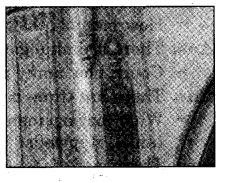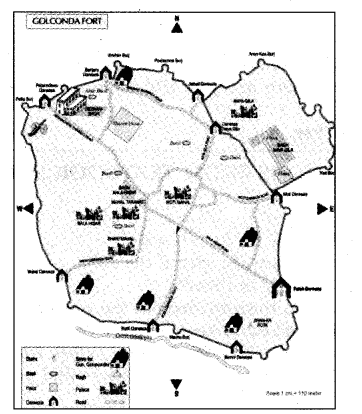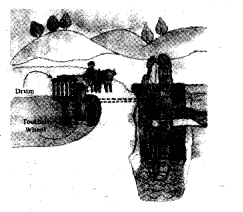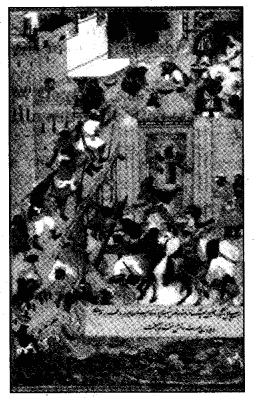NCERT Solutions for Class 5 EVS Chapter 10 Walls Tell Stories
1.Why were bastions made in the fort wall?
Ans. They were made to ensure security of the fort.
2.Why were big holes made in them?
Ans. Big holes were made in them to increase the viewing area. Soldiers could look through these holes and could keep a better vigilance.
3.What difference would be there if you were to look from a straight flat wall or a bastion at a height? How would the soldiers find peeping from the holes in the bastions useful while attacking?
Ans. Bastion ensured better safety of soldiers. It also provided a better vantage point from where a larger area could be seen. It would not have been possible from a flat wall.
Think and Discuss
1.How would the fountains have worked?
Ans. Fountains would have got water supply from a large reservoir.
2.What arrangements would have been made in the building for air and light?
Ans. Large windows, doors and ventilators allowed natural sunlight to enter the building. These also allowed lot of fresh air to come in.
3.Look carefully at the picture of the beautiful carving on the wall. What kind of tools would have been used for such fine carving?
Ans. These carvings would have been made using chisel and hammer which were made of iron.
Where is East-West?
1.At the place you are, where does the sun rise? Where does it set? Where you are standing, find out what all is there to your east? What all is there to your west? Also find out, what places are to your north and south.
Ans. The sun rises in the east and sets in the west. I am standing in my balcony. I can see a huge park in the east. I can see an old ruin in my west.
Tell and Write
Look carefully at the map of Golconda. On the map, arrows show all the four directions:
1.If you are peeping inside from Bodli Darwaza, in which direction from you is Katora Hauz?
Ans. In the north direction.
2.If someone is entering from Banjara Darwaza, in which direction from her is Katora Hauz?
Ans. In the south direction.
3.In which direction will you walk from Bala Hisar to reach Moti Mahal?
Ans. In the east direction.
4.How many gates can you see on the outer walls of the fort?
Ans. There are nine gates.
5.Count how many palaces are there in the fort?
Ans. There are three palaces.
6.What arrangements for water can you see inside the fort? For example; wells, tanks, stepwells.
Ans. There were five baolis and three hauz for water.
7.On the map, 1 cm distance is equal to a distance of 110 metres on the ground. Now tell: On the map, the distance between Bala Hisar and Fateh Darwaza is cm. On the ground, the distance between’the two would be metres.
Ans. On the map, the distance between Bala Hisar and Fateh Darwaza is 8 cm. On the ground, the distance between the two would be 880 metres.
8.How far is Makai Darwaza from Fateh Darwaza?
Ans. About 100 metres.
Discuss
1.Have you recently read or heard about any country attacking or going to w|ar with another country?
Ans. Yes, recently the USA had attacked Iraq.
2.Find out what was the reason for this war.
Ans. The USA wanted to topple the Iraqi president Saddam Hussain.
3.What kind of weapons were used in this war?
Ans. Many sophisticated fighter planes, tanks, helicopters, machines-guns, missiles, etc. were used in this war.
4.What kind of destruction was caused because of this?
Ans. There was a huge loss of life and property. Thousands of people were killed and numerous buildings were damagedr
Find Out
The big gun that Shreedhar saw was made of bronze.
1.Have you seen anything made of bronze? What?
Ans. Yes, I have seen diyas and statues made of bitonze.
2.Find out from your elders about some of the thijngs made from bronze that were, or are still used in your house. From its colour try to identify which one of them is made from copper, which from brass and which from bronze?
Ans. I could find following items:
Copper items: Lota, tumbler
Brass: Lota, puja thali
Bronze: Statue of natraja
Arrangements for Water
1.The picture shown here is made after seeing a very old painting of those times. Can you think why bullocks have been used here?
Ans. The bullocks have been used to draw water.
2.Use your hand movement to show in which direction the drum attached to the rod moves when the bullocks move?
Ans. The drum moves in anticlockwise direction.
3.In which direction would the ‘toothed wheel’ move?
Ans. In clockwise direction.
4.Now imagine, how would this garland of pots lift water from the well?
Ans. The garland of pots is connected with the ‘toothed wheel’ and thus the garland of pots moves. Once a pot is in water, it gets filled with water. The pot moves upward, carrying water along with it. Once the pot reaches the level of the canal, water is emptied in the canal.
5.Do you now get some idea about how the tanks could have been filled by lifting water from the wells?
Ans. Yes, bullocks could have been used to move the garland of pots to lift water up to the tank.
6.Where else have you seen such wheels attached to each other? For example— in, the gear of a cycle or somewhere else?
Ans. I have seen such arrangement in mechanical watches, sewing machine, heavy machines and in toy cars.
7.Look around and find out how water is pumped up from the ground to higher places?
Ans. These days, electric water pumps are used for lifting water to a higher place. In some villages, bullocks are still in use for the purpose.
8.How is water pumped using electricity? How is water lifted without electricity?
Ans. The electric motor runs the water pump which suck water from under the ground or from the tank. In the absence of electricity, hand-pumps and pulleys are used for lifting water.
Close Your Eyes and Go Back in Time!
1.What is the Sultan doing in the palace? What kind of clothes is he wearing? What dishes are being offered to him? But why does he seem so worried? And in what language is he talking?
Ans. The Sultan is holding a meeting with his ministers. He is wearing traditional dress and lots of jewellery. Many types of mughlai food, drinks and sweet dishes are being offered to him. He seems to be worried about the possible attack from the enemy kingdom. He is talking in Persian.
2.Imagine the rooms in the palace-—the beautiful carpets and curtains, the fountains on the terrace…and the sweet smell of roses and chameli—where is this coming from?
Ans. The rooms are looking grand. There are beautiful Persian carpets with intricate designs. Curtains are embroidered with gold. There is a beautiful garden on the terrace from where the sweet smell of roses and chameli is coming.
3.What are the different kinds of factories you can see? How many people are working there? What are they doing? What are they wearing? How long do you think they work?
Ans. I can see factories where clothes, utensils, idols, artifacts and arms are being made. About 20 people are working in a factory. They are working with their tools. They are wearing dhoti. I think they work for long hours; right from the early mornings to late evenings.
4.Look there! See how finely those craftsmen are carving the stones using a chisel and hammer? Can you see the stone dust in the air? Do you think this stone dust would harm them in some way?
Ans. Yes, I can see stone dust in the air. Stone dust can harm them if they do not take precautions. I can see that most of them have wrapped a cloth around their nose.
Write
1.What kinds of pots have you seen around you?
Ans. I have seen pots made from different items like steel, aluminium, brass, copper and plastic.
2.Try to find out from your grandparents about the other kinds of pots and pans they used in their time.
Ans. During my grandparents’ time most of the pots were made from brass and they were pretty heavy. Some of the pots were also made from clay. Copper was also used.
3.Have you ever been to some museum or heard about it? What all things are there in a museum?
Ans. Yes, I had visited the Salaijang Museum in Hyderabad. There are many antique artifacts, manuscripts and garments kept in the museum.
Survey and Write
1.Is there any old building or monument near your house which people come to see? If yes, name it.
Ans. Yes, I live in Mehrauli in Delhi and Qutub Minar is near my house. It is a historical monument. A large number of people come to visit it.
2.Have you ever gone to see an old monument? Which was that? Did you feel it told you a story? What could you know about those times from it?
Ans. Yes, I had gone to see the Red Fort in Delhi. When I was in the Red Fort complex, I could visualize the glory of the Mughal Empire. I could know about architecture of the time when this fort was built.
3.How old was it? How did you know?
Ans. This is about 400 years old. I have read about it in a book.
4.What was it made of?
Ans. The Red Fort is made of red sandstone.
5.What colour was it?
Ans. It is of red colour.
6.Were there any special kind of designs on the old building? Draw them in your notebook.
Ans. Yes, there were special geometrical designs on the building.
Note: Search for the images of jaalis in the Red Fort and draw a simple design looking at them.
7.Who used to live there in the olden days?
Ans. The Mughal Kings; right from Shah Jahan to Bahadur Shah Jafar used to live there.
8.What kinds of activities took place there?
Ans. It was bustling with activities; like normal day-to-day activities, bazaars and martial exercises.
9.Do some people still live there?
Ans. Now nobody lives there.
Look at the Painting and Tell
1.What kinds of work are people doing?
Ans. People are working on a construction site. Some people are carrying water, while some people are fixing bricks.
2.How many men and women are working?
Ans. About 20 men and 2 women are working.
3.See, how they are taking the huge pillar up along the slope? Is it easier to lift a heavy thing straight up or along a slope?
Ans. It is easier to lift a heavy thing along a slope than straight up.
4.Were you able to see the man carrying water in a mashak (leather bag)?
Ans. Yes, I could see the man carrying water in a mashak.
What We Have Learnt
1.Sangeeta thinks it is useless to keep old things in a museum. How would you convince her that it is important to have a museum?
Ans. Various antique things are kept in the museum. They tell us a lot about ancient times. We come to know about people and culture by looking at the things kept in the museum. Hence, museum is very helpful for us.
2.Why do you think, the chapter is named ‘Walls Tell Stories’?
Ans. The chapter is about historical structures which had been witnesses to their times. They tell a lot about the people, art, culture, craft, technology and events of the historical period. Hence the name ‘Walls Tell Stories’ is appropriate for this chapter.